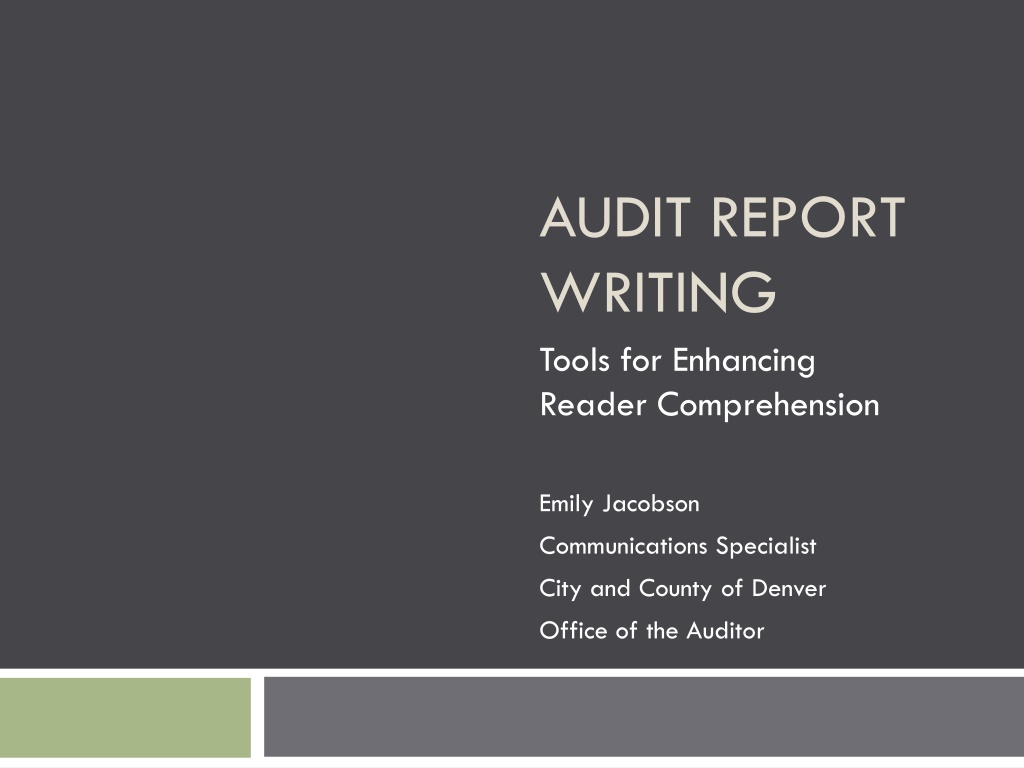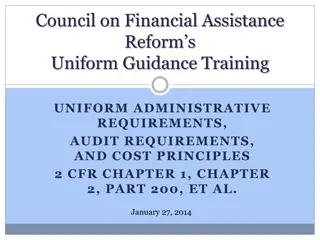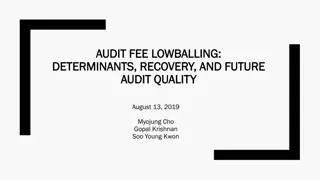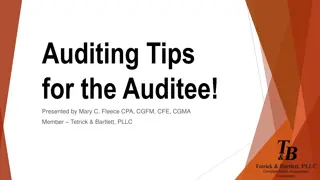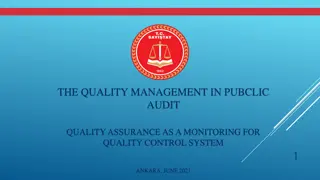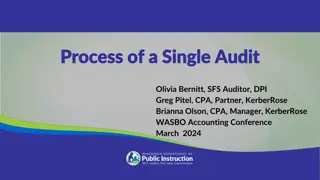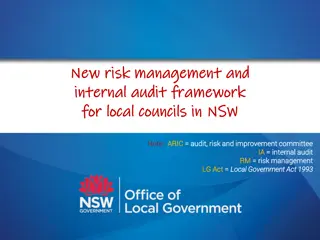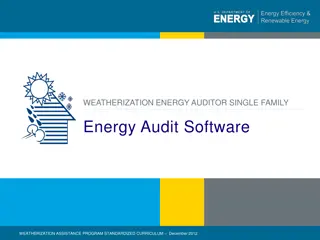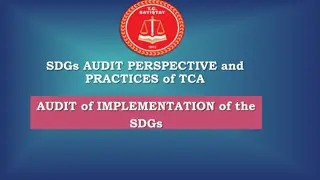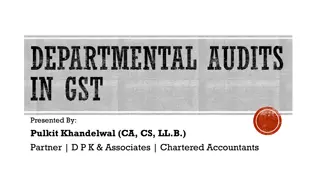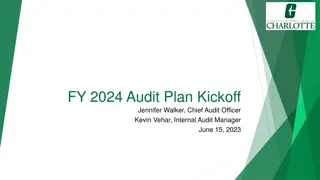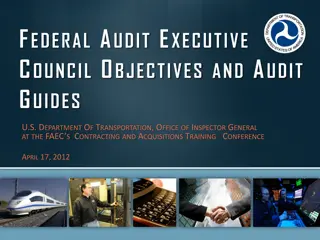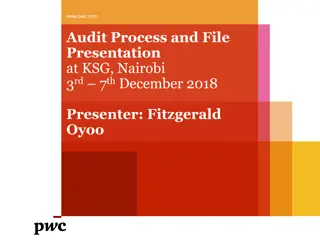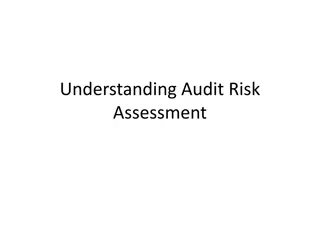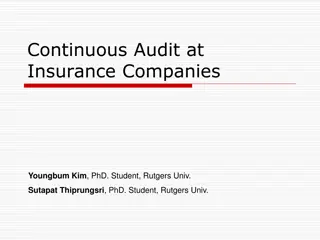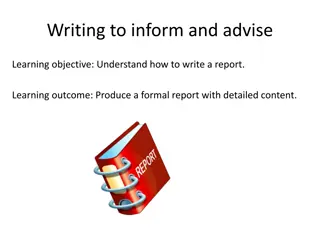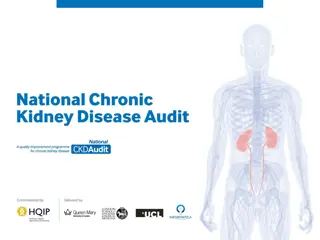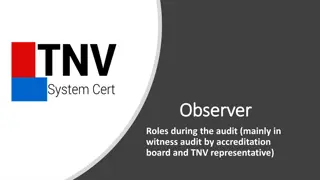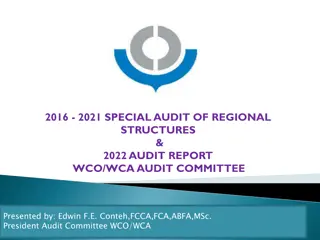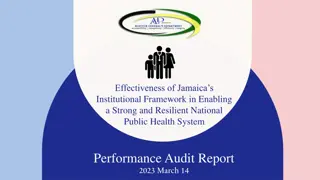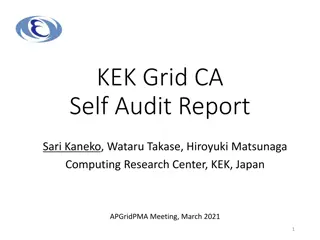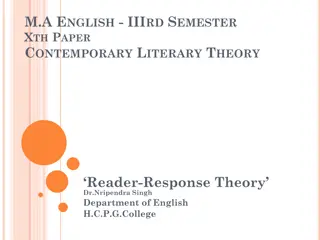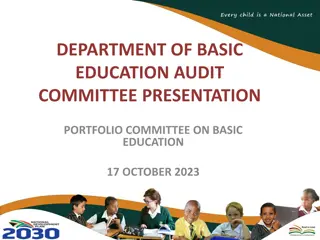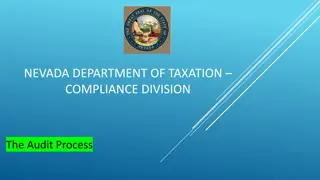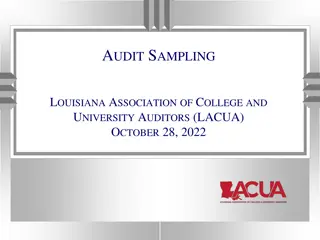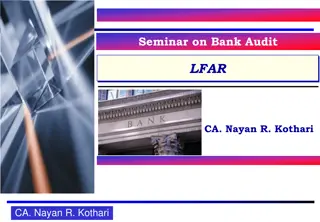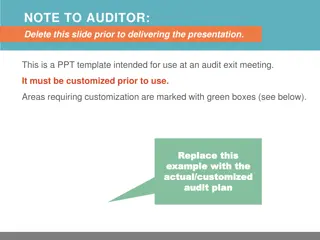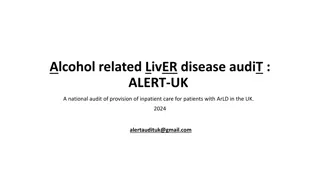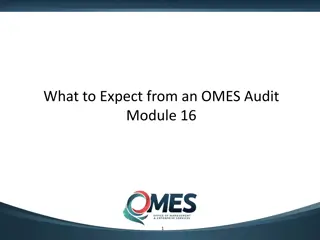Enhancing Reader Comprehension in Audit Report Writing
Tools for improving reader comprehension in audit report writing, including deductive writing, economy of words, and descriptive headings. Learn the difference between inductive and deductive writing and how to make audit reports more engaging and informative. Practical examples provided.
Download Presentation

Please find below an Image/Link to download the presentation.
The content on the website is provided AS IS for your information and personal use only. It may not be sold, licensed, or shared on other websites without obtaining consent from the author. Download presentation by click this link. If you encounter any issues during the download, it is possible that the publisher has removed the file from their server.
E N D
Presentation Transcript
AUDIT REPORT WRITING Tools for Enhancing Reader Comprehension Emily Jacobson Communications Specialist City and County of Denver Office of the Auditor
Opening Remarks 2 Moderator R. Kinney Poynter Executive Director NASACT Speaker Emily Jacobson Communications Specialist City and County of Denver (CO)
LEARNING OBJECTIVES 3 Deductive Writing Understand the difference between inductive and deductive writing, and why deductive writing is beneficial for audit reports. Economy of Words Recognize when you are using too many words to explain a concept or make a point, and learn how to cut your words by at least 10 percent. Descriptive Headings How adding greater detail to your headings can help busy readers navigate lengthy reports.
DEDUCTIVE WRITING Reasoning: Induction v. Deduction Inductive Writing Deductive Writing The Case for Deductive Writing in Audit Reports
INDUCTION v. DEDUCTION 5 Approaches to Reasoning: Induction Moving from specific observations to broader generalizations and theories Build up to conclusion Bottom-up approach Deduction Working from the more general to the more specific Begin with conclusion Top-down approach
INDUCTIVE WRITING 6 Inductive Writing Concrete to abstract Start with details and lead your reader to the conclusion Allow your readers to discover things with you Keeps the reader s attention, as he or she must read all the pieces of the puzzle before they are connected
INDUCTIVE WRITING EXAMPLE 7 My dog Max wants to chase every non-human living creature he sees, whether it is the cats in the house or rabbits and squirrels in the backyard. Sources indicate that this is a behavior typical of Jack Russell terriers. While Max is a mixed breed dog, he is approximately the same size and has many of the typical markings of a Jack Russell. From these facts along with his behaviors, we surmise that Max is indeed at least part Jack Russell terrier.
INDUCTIVE WRITING EXAMPLE 8 Within that short paragraph, you learned about Max s manners and a little about what he might look like, and then the concluding sentence connected these ideas together.
CASE FOR INDUCTIVE WRITING 9 Purposes for this kind of writing include: Creative writing Persuasive essays Speeches Used for controversial topics to maintain reader attention Helps you clarify (not prove) your stance to insure logical progression and conclusion
DEDUCTIVE WRITING 10 Deductive Writing Abstract to concrete Start with the conclusion, then supply the supporting evidence Use if your audience is not likely to read the entire piece Allows the reader to look for what he or she wants by quickly scanning first sentences of each paragraph
DEDUCTIVE WRITING EXAMPLE 11 My backyard is in dire need of cleaning and new landscaping. The Kentucky bluegrass that was planted there five years ago has been all but replaced by Creeping Charlie, a particularly invasive weed. The stone steps leading to the house are in some disrepair, and there are some slats missing from the fence. Perennials were planted three years ago, but the moles and rabbits destroyed many of the bulbs, so we no longer have flowers in the spring.
DEDUCTIVE WRITING EXAMPLE 12 The reader knows from the very first sentence that the backyard is a mess! The next three sentences give examples of why (your evidence).
CASE FOR DEDUCTIVE WRITING 13 Appropriate for: business letters project documents scientific writing research papers Use when the reader is more likely to skim the work for generalities or to hunt for only the parts that are important to him or her.
Polling Question 1 of 2 14 For individuals: Please be sure to answer the polling questions as they are also your attendance checks for today s webinar. For groups: Please answer in a way that reflects the consensus of the group. Attendance for groups is still monitored via the sign-in sheet. Don t forget to send in your questions!
ECONOMY OF WORDS Defining Word Economy Common Sources of Wordiness Before & After (60% reduction)
ECONOMY OF WORDS 16 What is Word Economy? Reducing the number of words used to convey a point Common Sources of Wordiness: Attempts to meet length requirements Attempts to sound more sophisticated Lack of attention to detail Not thinking about your audience
EXERCISING WORD ECONOMY 17 Why do it? Clarity Time When to do it: During the editing process. Don t worry too much about it when writing your first draft. Just get your thoughts down.
EXERCISING WORD ECONOMY 18 Eliminate formal and archaic expressions: henceforth for all intents and purposes suffice to say deem it inappropriate pursuant to his request null and void
EXERCISING WORD ECONOMY 19 Eliminate redundancies: official business current trend new innovation advance planning end result first priority basic fundamentals entirely eliminate join together
EXERCISING WORD ECONOMY 20 Avoid clich s: any way, shape, or form in the final analysis leaves much to be desired at the end of the day a step in the right direction in this day and age par for the course the path of least resistance
EXERCISING WORD ECONOMY 21 Don't use vague, wordy expressions when you can't or don t want to be precise about a number. Instead, use one simple word to express the concept. Wordy Expression Simple Alternative a great number of times often a little less than almost a small number of few a large number of many once in a great while seldom in the majority of cases usually
EXERCISING WORD ECONOMY 22 Don t fear simplicity! Excessive wordiness do not equal eruditeness. Wordy Succinct at no time never at this point in time now in the near future soon during the time that while called attention to the fact reminded draw to a close end due to the fact that because despite the fact that although on behalf of for in the event that if
EXERCISING WORD ECONOMY 23 Example from a report on Family and Medical Leave Act Administration Original: 295 words Revised: 119 words
EXERCISING WORD ECONOMY 27 Opt for succinct phrasing: their own internal identified best practices best practices in a way that is consistent with in accordance with to get further clarification for clarification reviewing certifications to ensure they are complete and contain sufficiently detailed information reviewing for completeness Examples of these practices are outlined below as follows:
EXERCISING WORD ECONOMY 28 Use bullet lists to your advantage No need to repeat similar introductory phrases with each bullet: Each of the agencies reported that they Leave teams reported All agencies reported Six of the agencies reported while two of the agencies reported
EXERCISING WORD ECONOMY 29 Remove excessive detail: Specific material that was already communicated e.g., listing the agencies with their own HR teams Nuances that do not affect overall message e.g., sufficient to state that agencies assessed for ADA eligibility, not the slightly different ways in which they did so Unnecessary caveats e.g., no need to say that the agencies have slight differences in how they administer; only matters that they are all doing so in accordance with best practice
Descriptive Headings An Instance Where More Is Better
AUDIT REPORT HEADINGS 31 Headings in Audit Reports: Provide a road map for the reader Clarify the main points before you make them Allow the reader to skim more effectively Complement the deductive approach Act as an outline
BACKGROUND SECTION EXAMPLES 32 Minimal Heading Descriptive Alternative Assets Types of Assets Owned by the City and County of Denver Voter Approval Designated Park Land Cannot Be Sold Without Approval of Denver Voters DSBO Division of Small Business Opportunity Structure and Responsibilities
HEADING HIERARCHY 33 DIA s Airport Concession Disadvantaged Business Enterprise Program Requirements Program Plan Certification Activities Compliance Activities Setting Program Goals Annual Non-Car Rental Goal Setting Concession-Specific Goal Setting Reporting
HEADING HIERARCHY 34 Community Policing Theoretical Foundations of Community Policing Direct Interaction between Police and Community Members Effectiveness of Community Policing Legal Considerations Surrounding the Self-Initiated Actions Associated with Community Policing
FINDING SECTION EXAMPLES 35 Minimal Heading Descriptive Alternative Financial Reporting Controller s Office Has Enhanced Capital Asset Financial Reporting Expand FAR 4.2 Capital and Controlled Assets Fiscal Accountability Rule Should Be Expanded to Include Practices Specific to Land and Infrastructure Reporting Disposal of Traffic Signals Not Removing the Correct Traffic Signal from the System of Record Potentially Causes an Overstatement of Asset Values Parks Designation Policy The Department of Parks and Recreation Has Designated Additional Parks but Has Not Formally Adopted the Draft Parks Designation Policy Contract Administration Technology Services Can Strengthen Contract Administration Practices for the Vendor That Provides After-Hours IT Support Policies and Procedures The Board s Outdated Policies and Procedures Do Not Reflect Current Administrative Practices
HEADING HIERARCHY 36 The Board Appears To Be Operating in a Professional and Unbiased Manner The Mayor Judiciously Appoints Board Members from an Open Pool of Candidates Board Members Are Appointed Based on Relevant Professional Experience No Evidence That Board Decisions Are Influenced by the Mayor
HEADING HIERARCHY 37 DIA s Emergency Plan Complies with FAA Requirements and Personnel Appear Prepared for Emergencies DIA s Emergency Plan Is FAA Compliant and Is Effectively Updated DIA Has a Skilled, Full-Time Emergency Preparedness Staff Strong Coordination and Collaboration Exists between Airport Personnel and DIA First Responder Groups
HEADING HIERARCHY 38 Weak Internal Controls Surrounding Open Media Foundation Asset Procurement and Accounting Practices DMS Is Not Using the City s Established Procurement Process Open Media Foundation Has Made Payments to Questionable Vendors OMF Assets Are Not Reported Timely Utilizing the City s Established Procurement Processes Can Reduce Risk
In Closing 39 Deductive Writing: Don t bury the lead Economy of Words: Less is more Descriptive Headings: More is more
Polling Question 2 of 2 40 For individuals: Please be sure to answer the polling questions as they are also your attendance checks for today s webinar. For groups: Please answer in a way that reflects the consensus of the group. Attendance for groups is still monitored via the sign-in sheet. Don t forget to send in your questions!
Question and Answer Session 42 Moderator R. Kinney Poynter Executive Director NASACT Speaker Emily Jacobson Communications Specialist City and County of Denver (CO)
Attendance Check 43 FOR INDIVIDUALS ONLY Please type I have completed the webinar. in your Question toolbar. Be sure to hit the send button after typing your response.
